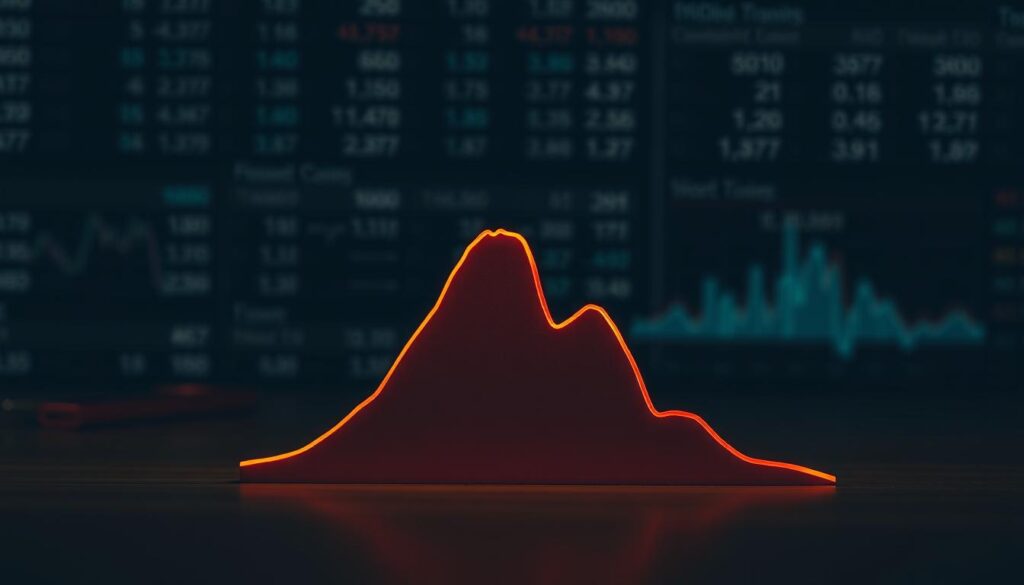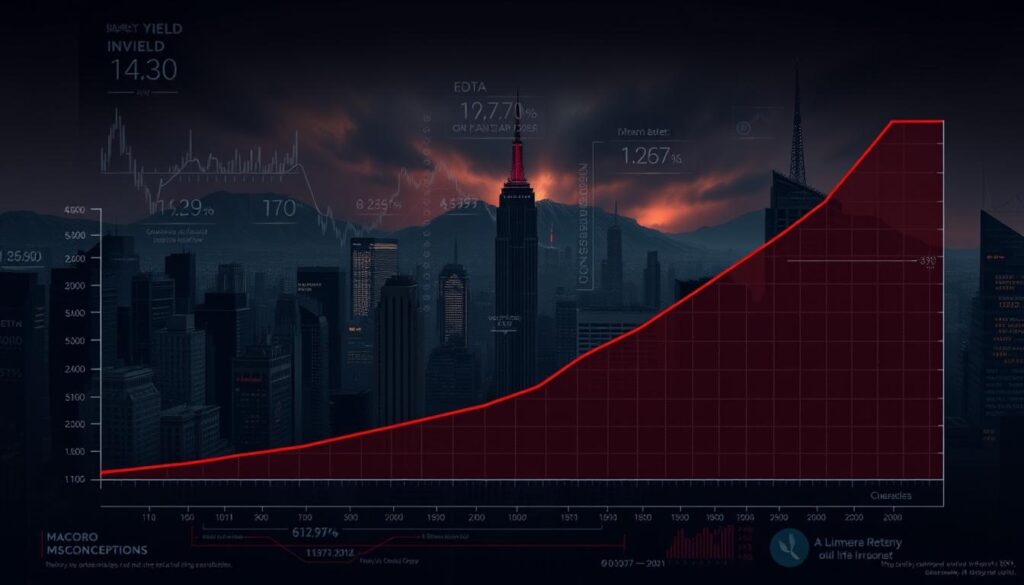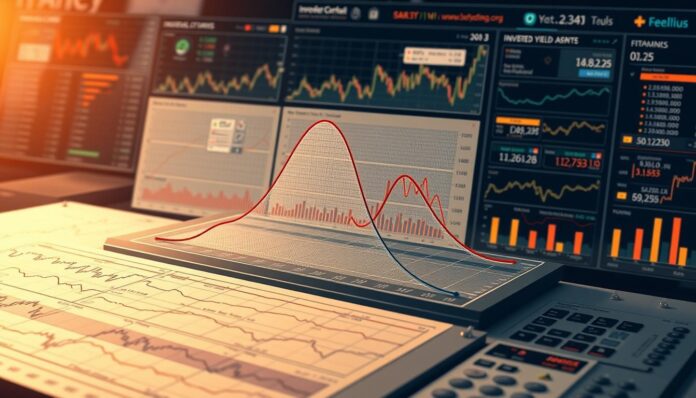The inverted yield curve has long been a topic of intense debate in financial circles. This economic signal, often seen as a recession indicator, flips the usual relationship between short-term and long-term interest rates. When short-term rates rise above long-term ones, investors and economists take notice. But does this really mean an economic recession is near?
Today, as markets watch trends closely, the question remains: How reliable is the inverted yield curve as a predictor? This article explores its history, current trends, and what it might—or might not—say about the economy’s future. We’ll break down why professionals track this curve and whether it’s time to prepare for an economic recession.
Key Takeaways
- The inverted yield curve is a key recession indicator studied by financial experts.
- Historically, it has often preceded economic downturns, but not always.
- Understanding its role helps individuals and businesses plan during uncertain times.
- Current trends and Fed policies shape how this curve impacts the economy today.
- Experts urge caution, noting no single signal guarantees an economic recession.
What is an Inverted Yield Curve?
A yield curve shows how interest rates for bonds change over time. Investors and economists track this graph to predict economic trends. Let’s break down its basics.
Definition of Yield Curve
Bond yields vary depending on how long a bond takes to mature. A standard yield curve plots these rates, with shorter-term bonds on the left and longer ones on the right. Normally, long-term bond yields are higher because investors demand more return for waiting longer. This forms an upward-sloping curve.
How It Works
An inverted yield curve flips this trend. When short-term rates rise above long-term ones, the curve slopes downward. This rare shift signals potential trouble. For instance:
- Normal curve: 2-year bond at 2%, 10-year at 3%.
- Yield curve inversion: 2-year at 3%, 10-year at 2.5%.
Such inversions have often preceded recessions, though not always.
Historical Context
Economists began using yield curves seriously in the 1980s. Since then, every U.S. recession since 1955 followed an inverted yield curve. The 2007 inversion, for example, preceded the 2008 financial crisis.
Tracking these shifts helps investors and policymakers prepare for economic shifts. The next sections explore why these curves invert and what they really mean.
Understanding Interest Rates
Interest rates are the engine driving decisions in financial markets. They determine how much it costs to borrow money and influence everything from mortgages to business loans. Let’s break down how these rates shape economic health.
Short-Term vs. Long-Term Rates
| Type | Example Rate | Influenced By |
|---|---|---|
| Short-Term | Federal Funds Rate | Central Banks |
| Long-Term | 10-Year Treasury Yield | Market Expectations |
Role of Central Banks
Central banks like the Federal Reserve act as economic guardians. By adjusting short-term rates, they steer borrowing costs to avoid economic recession. For example, raising rates can cool inflation but may slow growth. Their decisions ripple through bond yields, impacting long-term investment plans.
Interest Rate Impact on Economy
- Mortgage Costs: Higher rates make home loans pricier.
- Business Growth: Companies delay expansion when borrowing costs rise.
- Savings Returns: Higher rates boost savings accounts but may strain borrowers.
Rising bond yields signal shifting investor confidence. When long-term rates drop below short-term, the yield curve inverts—a red flag for markets.
The Mechanics of Yield Curves
Yield curves act like a financial barometer, signaling shifts in economic health. Let’s break down the three key shapes investors monitor closely.
Normal Yield Curve Explained
A normal yield curve slopes upward, reflecting typical growth expectations. Short-term rates stay low while long-term bonds offer higher returns as investors demand more for locking funds away. This pattern rewards patience, encouraging businesses to borrow affordably for expansion.
- Short-term rates
- Signals confidence in future growth
- Common during economic upswings
Inverted Yield Curve Defined
An inverted yield curve flips this order: short-term rates outpace long-term. This rare yield curve inversion often acts as a recession indicator, as seen before 2008 and 2001 downturns. Markets here suggest caution, with investors betting on slower growth ahead.
Flat Yield Curve Overview
A flat curve occurs when short- and long-term rates converge. This “pause” phase may precede either a return to normalcy or a deeper inversion. Analysts watch flattening trends closely as potential early warnings.
| Curve Type | Shape | Economic Signal |
|---|---|---|
| Normal | Upward slope | Healthy expansion |
| Inverted | Downward slope | Recession risk |
| Flat | Horizontal line | Potential transition phase |
These shapes guide decisions from retirement planning to corporate borrowing. For hands-on strategies during volatility, explore ways to stay calm amid market.
Historical Precedents of Inverted Yield Curves
History shows inverted yield curves often act as recession indicators. Since 1955, every U.S. economic recession was preceded by a yield curve inversion. These patterns reveal critical links between market signals and economic cycles.
Previous Instances in the U.S.
In 1980, 1989, and 2006, inversions signaled downturns within 12–18 months. The 2006 inversion preceded the 2007–2009 crisis, while 1989’s inversion foreshadowed the early 1990s slowdown. These examples highlight the curve’s role as a forward-looking tool.
Correlation with Economic Downturns
- Statistical analysis shows 70% of inversions since 1970 led to economic recession within 18 months.
- Time lags vary—sometimes years pass before downturns materialize, complicating predictions.
Case Studies: 2000 and 2008
In 2000, the tech bubble burst followed a 1999 inversion. The 2008 crisis was preceded by a mid-2006 inversion. Both cases show how recession indicators align with market collapses, though external factors like housing market failures in 2008 amplified impacts.
Bitcoin’s emergence post-2008 complicates modern comparisons. Unlike traditional safe havens like gold, its performance during the 2008 crisis isn’t testable—highlighting gaps in understanding new assets during economic recession phases.
Why Does an Inverted Yield Curve Predict Recessions?
An inverted yield curve acts as a red flag for economic recession, but its predictive power stems from deeper forces in financial markets. Let’s break down the chain of events that link interest rate shifts to economic trouble.
Investor Sentiment and Behavior
When investors fear a slowdown, they flee stock market dynamics, moving funds into long-term bonds. This demand drives bond prices up and long-term yields down, flipping the yield curve. This shift signals a loss of confidence in corporate profits and future growth.
Credit Markets and Borrowing Costs
Banks earn less when short-term rates exceed long-term ones. Narrow profit margins force lenders to tighten loans, slowing business expansion and consumer spending. Reduced credit access often precedes economic recession as companies struggle to fund operations.
Economic Indicators to Watch
- GDP Growth: Slowing output confirms weakening fundamentals.
- Unemployment Rates: Rising job losses indicate demand decline.
- Consumer Spending: Falling retail sales reflect reduced confidence.
These metrics, paired with yield curve data, create a clearer picture of recession risks. Analysts combine these signals to avoid relying solely on inverted curves.
Current Economic Landscape
Today’s financial markets are closely watching the inverted yield curve, a signal that’s historically preceded recessions. Recent data shows key Treasury yields—like the 2-year and 10-year notes—have inverted, with short-term rates exceeding long-term ones for months. This yield curve inversion raises questions about where the economy stands now.

Overview of Current Yield Curve Trends
- As of late 2023, the 2-year Treasury yield surpassed the 10-year yield, a classic sign of inversion.
- Analysts note the inversion’s duration: prolonged flattening since mid-2022 hints at persistent pressures.
Federal Reserve Policies
The Federal Reserve’s rate hikes in 2023 aim to curb inflation, but these actions push short-term rates higher. Policies like quantitative tightening also reduce bond market liquidity, amplifying yield curve inversion effects. Recent Fed statements emphasize balancing growth with price stability, complicating bond market dynamics.
Economic Indicators Impacting Yield Curves
“The yield curve’s shape today reflects a tug-of-war between high inflation and slowing consumer spending.” — Dr. Emily Torres, Economic Analyst at Goldman Sachs
Key metrics like the Consumer Price Index (CPI) and unemployment data influence investor sentiment. Rising wages and persistent inflation (6.2% in 2023 Q3) suggest the Fed may keep rates high longer, deepening the inverted yield curve’s impact on loans and corporate borrowing costs.
The Importance of Context
When interpreting the yield curve, it’s crucial to look beyond a single recession indicator. Economic trends rarely act in a vacuum, so understanding broader forces helps avoid overinterpreting isolated signals.
Other Economic Indicators to Consider
Key metrics like unemployment rates and consumer spending paint a fuller picture. For example:
- Unemployment Trends: Low jobless rates often signal strength, while sudden spikes may warn of slowing demand.
- Manufacturing Data: Durable goods orders reflect business confidence and industrial health.
- Consumer Sentiment: Surveys like the University of Michigan Index gauge public optimism, a driver of spending.
Global Economic Influences
Financial markets today are interconnected. Trade disputes or central bank policies in Europe or Asia can ripple into U.S. yields. For instance, the European Central Bank’s rate decisions or China’s trade policies directly affect global borrowing costs, altering domestic economic conditions.
Summary of Current Economic Conditions
As of 2023, mixed signals persist. While the yield curve inverts, low unemployment and steady consumer spending suggest resilience. However, supply chain disruptions and inflation trends add uncertainty. Here’s a snapshot:
| Metric | Current Level |
|---|---|
| Unemployment Rate | 3.8% (2023 Q2) |
| Consumer Sentiment | 65.7 (University of Michigan Index) |
| Manufacturing PMI | 52.4 (Expansion territory) |
These numbers show growth in some areas but highlight risks tied to global trade and energy costs. Context, not just the yield curve, guides informed decisions.
Expert Opinions on Inverted Yield Curves
Economists and analysts often debate the role of inverted yield curves as a recession indicator. While some view them as a near-certain economic recession signal, others argue context matters. Here’s what leading voices are saying:
Economists’ Perspectives
Noted economist Laurence Ball emphasizes that yield curve inversions have preceded every U.S. economic recession since the 1970s. However, Jan Hatzius of Goldman Sachs points out today’s global interest rate dynamics complicate traditional interpretations. Views range from cautious warnings to calls for calm.
Financial Analysts’ Insights
- Portfolio managers advise diversifying high-yield bonds into Treasuries during inversions
- Analysts at JPMorgan suggest monitoring corporate bond spreads alongside yield curves
- Some strategists argue equities can still rise early in inverted periods
Historical Accuracy of Predictions
Data shows the yield curve correctly signaled 7 out of 8 post-1950 recessions. Yet false positives occurred in 1966 and 1998. Experts agree it’s a strong but imperfect recession indicator. As Paul Krugman noted, “It’s a flashing caution light, not a certainty.”
Common Misconceptions
Many people believe the inverted yield curve is an economic death sentence. But this recession indicator isn’t as straightforward as headlines suggest. Let’s unpack the facts behind the fear.

Inverted Yield Curve Myths
- Myth 1: Yield curve inversion directly causes recessions. Reality: It’s a signal, not a trigger. Economic downturns stem from deeper issues like overleveraged markets or policy shifts.
- Myth 2: Every inversion equals an instant recession. Reality: The lag time varies—sometimes years pass before effects materialize, if at all.
Understanding the Nuances
Not all yield curve inversions are equal. The slope’s steepness, duration, and which Treasury maturities are inverted matter most. For instance, a brief yield curve inversion between short-term bonds might not hold the same weight as a prolonged inversion between 2- and 10-year Treasuries. As economist John Williams noted, “Markets often overreact to short-term fluctuations. The Fed monitors trends, not single data points.”
Avoiding Overgeneralization
Blaming the yield curve alone ignores other recession indicators. Pair it with jobless claims, manufacturing data, and consumer confidence. Overreliance on one metric risks missing the bigger picture.
“The yield curve is a mirror, not a crystal ball,” said a 2023 Federal Reserve analysis. “It reflects trends but doesn’t dictate outcomes.”
How to Prepare for Economic Uncertainty
Uncertainty in the financial markets demands proactive steps. Whether you’re managing personal finances or a business, strategic moves can safeguard stability. Start by focusing on what you can control.
Personal Finance Strategies
- Build an emergency fund covering 6–12 months of expenses.
- Prioritize paying off high-interest debt to reduce financial strain.
- Explore side income streams to diversify revenue during a potential economic recession.
Business Adaptation Techniques
Companies thrive by staying agile. Strategies include:
- Trim non-essential costs while maintaining core operations.
- Boost cash reserves to navigate disruptions in stock market dynamics.
- Strengthen customer relationships to retain loyalty during slowdowns.
Investing During Recession Fears
“Downturns create buying opportunities for long-term investors,” says economist Janet Yellen.
Balance portfolios with defensive stocks, bonds, and cash. Avoid drastic moves driven by fear. Monitor financial markets closely but avoid reacting to daily volatility alone.
Stay informed but focused on long-term goals. Small, consistent adjustments often yield better results than panic-driven decisions.
Conclusion: The Bigger Picture
As we wrap up this exploration of yield curves and their connection to economic trends, it’s clear the relationship between inverted curves and recessions isn’t always straightforward. While history shows a strong link, today’s economy operates under new pressures and policies. Let’s break down what this means for you.
Final Thoughts on Yield Curves and Recessions
Does An Inverted Yield Curve Mean Recession Is Coming? Past data suggests caution, but modern factors like global trade shifts and central bank policies complicate predictions. An inverted curve isn’t a guaranteed sign of economic recession—it’s one signal among many. Investors and businesses should analyze it alongside employment rates, consumer spending, and corporate earnings to gauge risks.
Future Outlook for the Economy
Economic forecasts remain uncertain, but trends in stock market dynamics and borrowing costs offer clues. Central banks like the Federal Reserve may adjust rates to stabilize growth, though inflation and geopolitical events add layers of complexity. Staying tuned to official reports and market trends helps separate noise from meaningful shifts.
Staying Informed and Proactive
Knowledge is your best tool. Monitor key indicators regularly, diversify investments, and keep emergency funds ready. While preparing for potential downturns is wise, avoid knee-jerk reactions. Economic cycles ebb and flow, and informed decisions today can build resilience for whatever comes next.

